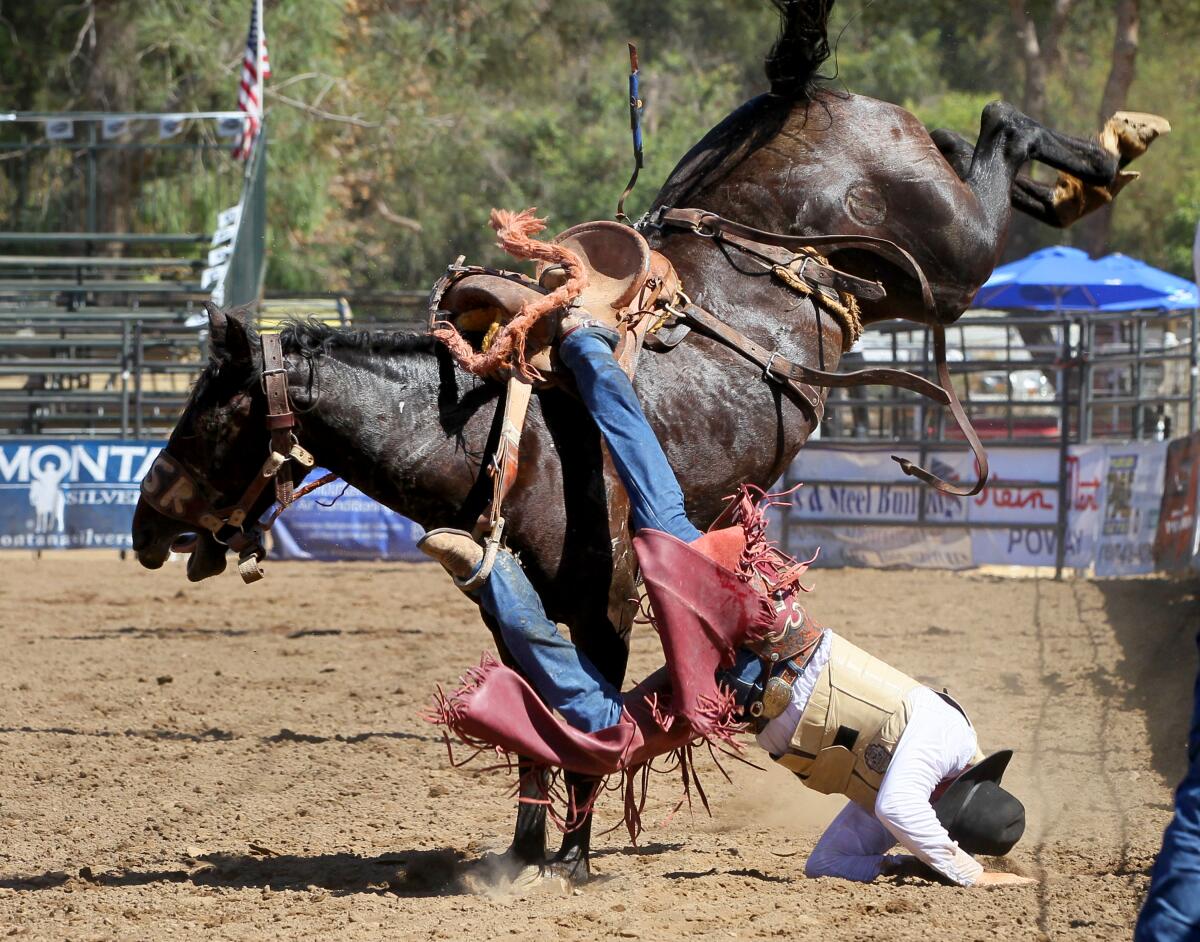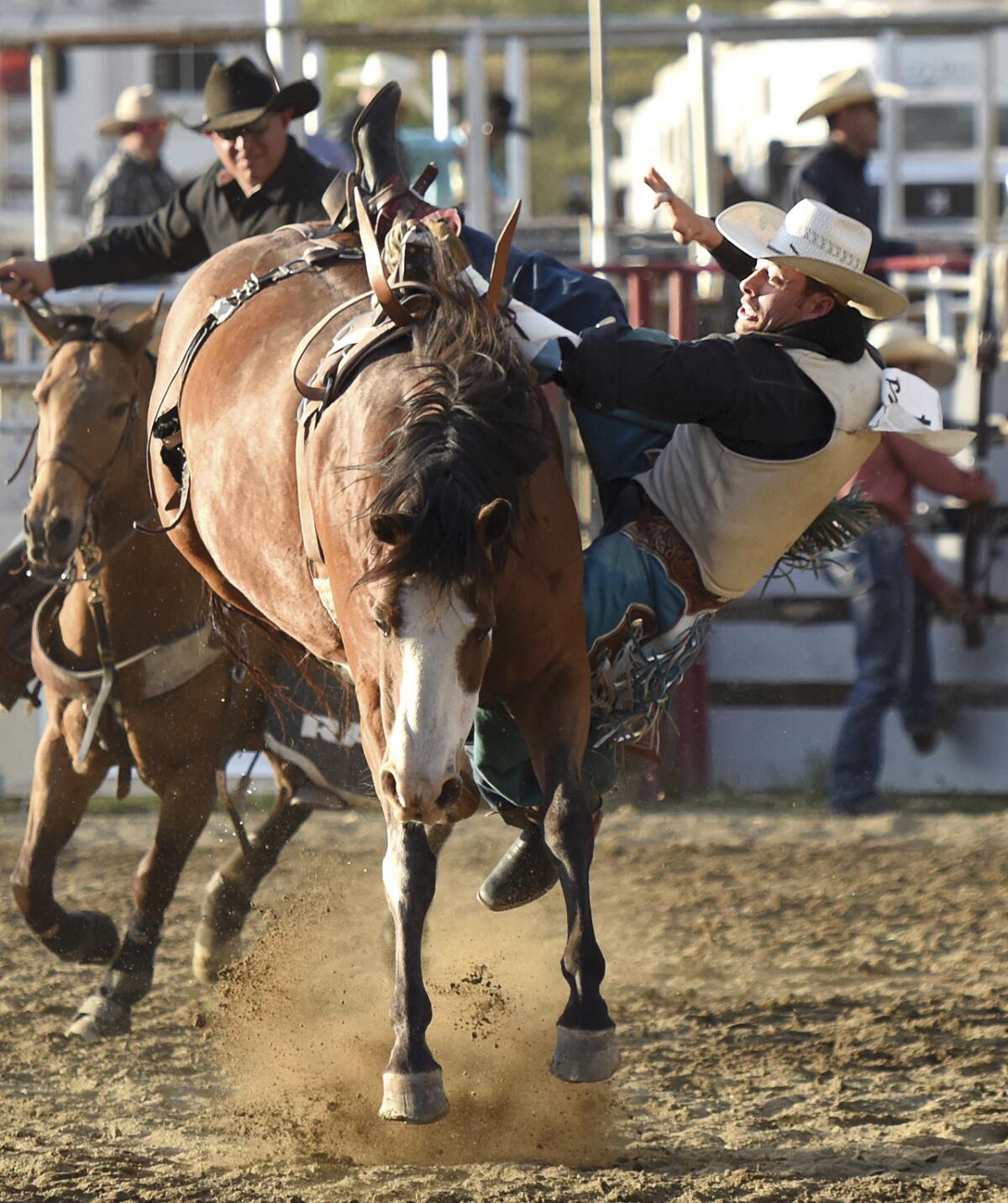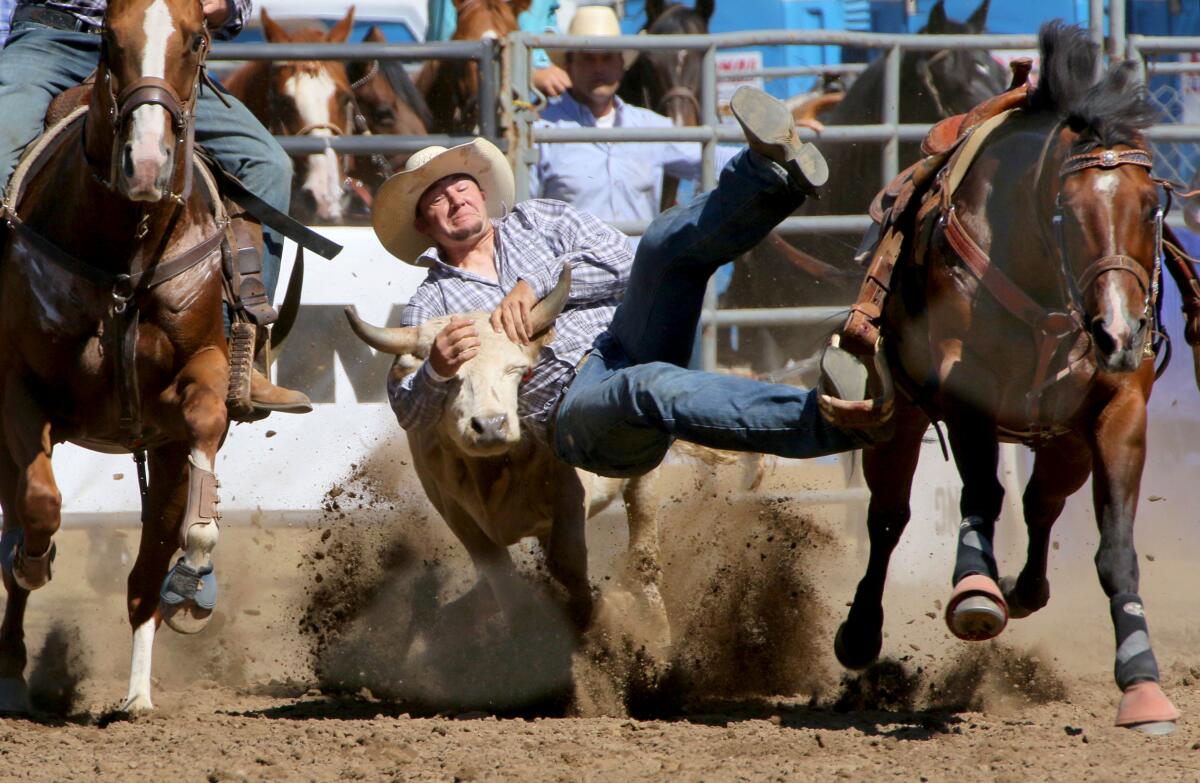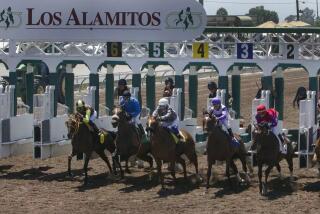California rodeo animals face violent and deadly casualties: Broken backs, legs and skulls

- Share via
As the Los Angeles City Council prepares to weigh in on a measure to effectively ban rodeos, a review of 21 years of rodeo animal injury reports shows a hidden, violent and deadly side to a sport heralded as an icon of American tradition.
A Times’ review of the reports shows that since 2001 — when a state a law went into effect requiring all rodeos to have a veterinarian in attendance or on call — more than 125 animal injuries have been reported. The reports were written by attending or on-call veterinarians and submitted to the California Veterinary Medical Board. The reports were acquired via a public records request.
No reports were issued in 2001, 2002, 2006, 2009 or 2020. Only twenty reports were issued before 2010.
The reports document injuries ranging from minor maladies such as the superficial abrasions suffered as panicked animals rushed out of their chutes, to crushed skulls, broken legs, gored flanks and snapped spines.
In 35 of the injury reports reviewed by the Times, the animal died immediately or within minutes of the accident, or had to be euthanized — or in one case, slaughtered — in the following hours or days. In 14 cases, the reports leave the fate of the severely injured animal unclear. In these cases, either the attending veterinarian was denied access to the animal, or the report did not provide information on the animal’s fate.
For instance, in 2016, Wayne Merhoff, a Red Bluff-based veterinarian, reported that a calf at the Red Bluff Round-Up had suffered a broken leg during a calf roping event. The owner of the calf refused to let Merhoff treat the animal, leaving its fate unknown.
“Personal property rights are in conflict with my efforts to attend to these animals,” Merhoff wrote in his report, noting that several animals had been reported injured at the round-up, but their owners refused to let him see them.
Merhoff could not be reached for comment.

In another case, a horse at the 2018 Folsom Rodeo fell during a bucking bronco event and lost the ability to move its hind legs. As Lisa Gamsjaeger, the attending veterinarian, rushed to get medicine for the horse, a team of cowboys rushed in and tied the horse’s feet together. By the time Gamsjaeger returned with the medicine, they’d put the hogtied horse into the back of a trailer.
“I could not assess the hind end as it was pushed into the corner of the trailer,” Gamsjaeger wrote that day. She noted the mare’s legs were still tied together. The owner insisted on taking the horse to Marysville — an hour’s drive away.
Gamsjaeger could not be reached for comment.
Douglas Corey, chairman of the Professional Rodeo Cowboys Assn.’s livestock welfare committee, said he could not comment on the reports or numbers cited by The Times. But he said that rodeos are very safe for animals, and that fewer than 0.05% of animals used in rodeos are injured.
He was unable to provide The Times with the data, reports or numbers used to derive that number; however, he said his organization keeps records and has veterinarians at every event.
“I don’t know of any deaths that I could tell you that actually happened in the arena,” he said. “I do know that I may have heard that a death of maybe a grand entry horse that maybe had an aneurysm. Maybe a pick-up horse not involved in an event may have had a heart attack. ... But that doesn’t necessarily mean an animal died from an actual event in an arena.”
A grand entry horse is one that is ridden or paraded at the beginning of a rodeo, when the national anthem is commonly sung and flags are waved. Pick-up horses are generally ridden into the arena to help a rodeo competitor get off a bucking animal.
Temple Grandin, author and professor of livestock medicine at Colorado State University, said the biggest threat to animals in the arena is bad training — not necessarily the devices Los Angeles is deciding whether to ban within city limits.
The ordinance seeks to ban items that can cause physical harm such as electric prods, flank straps, wire tie-downs, lassos, lariats and sharpened or fixed spurs.
“A good stock owner will have an animal so well trained” that injuries are negligible, Grandin said in an interview. She said deadly events occur when animals aren’t trained or habituated to arenas and crowds. Which is partly why she does not like calf roping or wild cow milking events, in which wild, skittish animals are chased.
“That’s when things get bad,” she said.
But Crystal Heath, a Bay Area veterinarian and former Grand National Rodeo Queen contender, said even trained animals run the risk of injury.
“I think we have to ask if scaring, provoking and potentially injuring animals — just for entertainment purposes — is something we support as a society. I don’t think that’s what the public wants,” she said.
In 28 of the of the 35 deaths reviewed by The Times, the animal died while performing. Twelve horses died in bronco riding events — rodeo performances in which a flank strap is cinched around a horse’s waist to make it buck. Riders try to stay atop the bucking horse for several seconds. One of these horses ran headfirst into a pole and died almost immediately; another went full speed into a metal gate and broke its neck. Others had their legs break underneath them as they bucked.

Other animals, such as bulls, steers, cows and calves, died during events including bull riding, steer wrestling, wild cow milking, bareback competition, bullfighting, stampede, wild horse racing, and calf roping.
In one particularly grisly event at the 2013 California Rodeo Salinas, a steer turned in front of a competitor’s horse, causing both to stumble. The horse then stepped on the steer’s neck, fracturing it. The steer was dead by the time it was taken out of the arena.
In many cases, it was fear and panic that led to the injury.
A horse performing in a 2011 bucking bronco competition “ran headfirst into a fence post and collapsed,” wrote Erin Contino, the on-call veterinarian at the Oakdale Rodeo. The mare collapsed, was unresponsive and died within a few minutes.
In another case, a cow at the Rowell Ranch Rodeo in Alameda County tried to run out of the arena, jumped a fence, landed on her face and, with a broken neck and eye protruding from its orbit, had to be euthanized.
It is unclear whether the reports compiled by the state are reflective of the actual number of injuries at events during the last two decades, or a vast undercount.
According to information provided by the Professional Rodeo Cowboys Assn., roughly 40 events are held annually throughout the state. That number doesn’t include Professional Bull Riders events or the scores of more informal community rodeos and charrerias that take place almost daily throughout the summer months.
Reports were issued by just 29 rodeos — with most not providing annual reports.
For instance, the Fortuna, Glenville, Stanislaus and Springville rodeos each issued only a single report over the 21 years for which the state has data. The veterinarian at the Clovis Rodeo has issued 32 reports since 2010.
“The fact that in some years no injuries were reported is statistically impossible,” said Eric Mills, coordinator for Oakland’s Action for Animals.
L.A. City Councilman Bob Blumenfield agreed.
Those reports are “just what was sent in. This stuff hardly gets reported,” he said. “I would have to believe it’s a vast undercount, and, even if it wasn’t, I don’t think it’s a very good statistic.”
Referring to Corey’s number, he said “they’re counting every sheep, dog and cat — animals that are not involved in the more dangerous activities or being prodded by these instruments of torture.”
The City Council’s three-member Personnel, Audits, and Animal Welfare Committee is scheduled to vote on the rodeo measure Wednesday. If it passes, the ordinance will go to the full council in January.
Blumenfield, who co-sponsored the bill and represents the San Fernando Valley, said the ordinance would not affect non-rodeo equestrian activities, which generally do not require the items singled out in the measure.
“This is about inhumane devices that are used in rodeos and whether or not we should continue that practice in 2022 and beyond,” he said.
More to Read
Sign up for Essential California
The most important California stories and recommendations in your inbox every morning.
You may occasionally receive promotional content from the Los Angeles Times.











